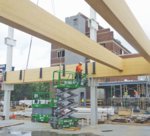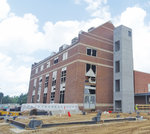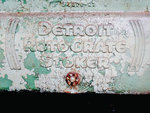



This summer, truckloads of titanic timbers from Canada are rumbling across Michigan State University to be unloaded and assembled into a structure that will be unique on campus, and in the state, when it’s finished in the fall of 2020.
Making their way around washouts from recent rains, workers are quickly muscling MSU’s $97.5 million STEM Teaching and Learning Facility into reality.
The building yokes two major projects together. At its heart is the 1946 Shaw Lane Power Plant next to Spartan Stadium. Idle for over 30 years, the stately brick and limestone pile will get a new life as a busy hub of classrooms, workshops and meeting spaces.
A shaky climb to the top of the power plant, where renovations are just beginning, affords a splendid view of two sprawling additions now going up to the north and south.
The additions are made of huge, handsome slabs of wood, called “mass timber,” that will remain exposed and also bear the weight of the structure. It’s the first building in the state to use this type of construction.
The new wings will add about 117,000 square feet to the old power plant’s 40,000 square feet.
The north annex is a little more than a concrete pad right now, but the south annex is taking shape fast. Last week, workers were swarming over the site, hoisting the timbers into place and fastening them into place with giant turnbuckles.
About $30 million of the project cost is coming from the state of Michigan. It’s the first time in 50 years the state has helped fund a classroom building on campus, according to MSU. (The last MSU classroom building to get state help was Wells Hall, across the street, back in 1969.)
The design team plans to maximize the steampunk potential of the old power plant. Two of the three massive boilers in the plant have been hauled away. The remaining boiler will be cleaned up, hollowed out and kept in place.
Set in the center of MSU, the new facility is designed to foster creative, cross-disciplinary thinking in the fields of science, technology, engineering and math. Enrollment in STEM courses has gone up 40 percent at MSU in the last 10 years, and many of the students are non-majors. Five of MSU’s colleges came together to come up with a matrix of unconventional, flexible spaces very different from the labs and classrooms of the past. Centralizing STEM classroom space at the new facility will have the added benefit of freeing up dozens of labs and classrooms scattered around campus for advanced research projects in agriculture, natural sciences, engineering and other fields.
Courses that require teamwork will have plenty of space on the old power plant’s airy, open fourth floor. A massive, cylindrical ash silo, lined with shiny ceramic bricks, will be converted to conference rooms and seating areas for meetings and workshops. A labyrinthine pump and pipe assembly on the fourth floor, a fascinating study in movement and stasis, will also stay in place.
“There’s no reason to pull it out,” project manager Ken Gottschalk said. “It’s not affecting anything, so we leave as much as we can.”
The industrial nuggets will be augmented by new art.
Unfortunately, the plant’s old smokestack with the letters “MAC,” for Michigan Agricultural College, didn’t make the cut.
“We could have restored it, but it was not a functioning smokestack,” Gottschalk said. “It was cool to have, but it was safest to bring it down.”
While renovation of the plant has barely begun, the additions are going up fast. The new wings are made largely of “mass timber,” a mix of solid and glued wood strong enough to bear the weight of the building and pretty enough to be left exposed. There are currently no mills that make mass timber in Michigan, so the slabs are being hauled from Canada.
But the U.S. Forest Service and MSU’s Forestry Department are tracking the STEM project closely, with an eye toward developing a mass-timber market in Michigan. Forestry Department Chairman Rich Kobe said mass timber is already in widespread use in Europe and the stuff is beginning to take off in the United States, with an 80-story structure planned in Chicago, and in Canada, where an 18-story tower in Vancouver, British Columbia, is already standing.
Designers love mass timber, with its warm feel and sleek look. Urban planners and some environmentalists speculate that the stuff may even rescue the world from a new round of carbon-spewing construction expected by 2050, to house a global surge of two billion new city dwellers.
“Growing trees sustainably, using all of the harvested wood and incorporating it into a long-term structure, extends the carbon and climate benefits of forests,” Kobe said. Building from steel and concrete emits carbon dioxide, while mass timber sequesters the carbon in the wood.
But it’s not clear that the carbon used in the manufacturing of mass timber outweighs the benefits of sequestering it. Advocates point out that mass timber can be pressed together from smaller pieces of wood, lessening the pressure to cut down older trees, but skeptics fear a growing market will lead to more heedless clear-cutting.
Helen Taylor, Michigan director of The Nature Conservancy, said sustainable management is key.
She praised mass timber as “a big carbon sink.”
“We’re hoping, by building a building like this, and others, it will create more demand and take us closer to inspiring people to do that here,” Taylor said.
Taylor said a domestic market for mass timber would create incentive for landowners to enroll their forests in Stewardship Council certified land.
“We have a lot of forest in Michigan,” she said. “If we’re going to have a timber industry, let’s do it right.”
The unresolved questions about mass timber make MSU’s STEM project — future home to many experiments and arguments — a grand experiment in itself.
Support City Pulse - Donate Today!
Other items that may interest you

Comments
No comments on this item Please log in to comment by clicking here